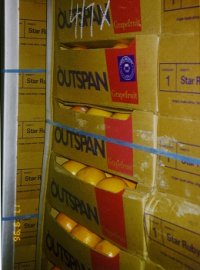The packaging materials must not react with the goods (foodstuffs). The packaging must be readily stackable, resistant to compression, impact and breakage as well as providing protection against moisture, i.e. the cartons must be made from wet strength paperboard since moisture will otherwise make them bulge, especially in the lower layers (see Fig. 101).
 |
Figure 101: When the cardboard was selected for these orange cartons, insufficient attention was paid to whether the material was adequately insensitive to moisture or exhibited wet strength. Moisture in the cardboard has caused the cartons in the lower layers on the pallet to bulge out considerably and they now run the risk of being damaged when moved about with forklift trucks. Such inadequate packaging can result in considerable damage, if the pallet width was originally precisely matched to the truck width. Photo: Förster/ Ahrens [12] |
Packaging also plays an ever greater promotional role, since chilled products are provided with attractive sales packaging, in which they are also transported. See-through packaging allows the purchaser to assess the contents to a certain degree. For example, the purchaser will be disturbed by drops of condensation water visible on the inside of the packaging. The current trend is towards transporting goods in the retail portions (foodtrays (small packages)) in which they will be offered for sale to the customer on the retailer's shelves.
Packaging must additionally be environmentally friendly and recyclable: packaging used for highly perishable goods cannot generally be reused for reasons of hygiene.